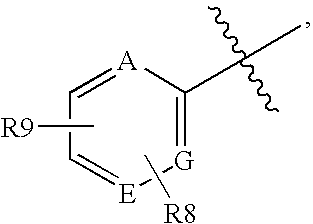Glucagon Receptor Antagonists, Preparation and Therapeutic Uses
- Summary
- Abstract
- Description
- Claims
- Application Information
AI Technical Summary
Benefits of technology
Problems solved by technology
Method used
Image
Examples
preparation 1
Ethyl 3-(4-Hydroxybenzoylamino)propionate
[0175]
[0176]Diisopropylethylamine (DIPEA, 25.3 mL, 145 mmol) is added dropwise to a solution of EDCI (13.8 g, 72.5 mmol), 4-hydroxybenzoic acid (10.0 g, 72.5 mmol) and ethyl 3-aminopropionate (11.1 g, 72.5 mmol) in THF (700 mL) at room temperature under nitrogen, after which the mixture is stirred for 7 h. The mixture is diluted with water (200 mL) and saturated aqueous sodium bicarbonate solution (100 mL) and extracted with ethyl acetate (3×200 mL). The combined organic extracts are washed with water (100 mL) and brine (100 mL), dried (MgSO4) and the solvents are removed under reduced pressure. The residue is purified by flash column chromatography on silica gel, eluting with hexanes / ethyl acetate (1:1 to 1:4), to afford ethyl 3-(4-hydroxybenzoylamino)propionate as a white crystalline solid (13.59 g, 79%): 1H NMR (CDCl3, 300 MHz) δ 1.27 (t, J=7.14 Hz, 3H), 2.64 (t, J=6.16 Hz, 2H), 3.71 (dt, J=6.09, 11.85 Hz, 2H), 6.86 (d, J=8.70 Hz, 2H), 6.8...
preparation 2
3-(4-Hydroxy-benzoylamino)-propionic acid methyl ester
[0177]
Step A. 3-(4-Benzyloxy-benzoylamino)-propionic acid methyl ester
[0178]To a mixture of 4-benzyloxybenzoic acid (8.92 g, 39.08 mmol) and 3-amino-propionic acid methyl ester hydrochloride (6.00 g, 42.98 mmol) in CH2Cl2 (100 mL) was added DMAP (catalytic), triethylamine (6.60 mL, 47.35 mmol), and EDCI (9.00 g, 46.94 mmol). The mixture was stirred at RT for 12 h. The mixture was diluted with CH2Cl2. The organics were washed with 1N HCl, 2N NaOH, water, and brine (1×100 mL each), and dried with MgSO4 to yield 11.28 g (92%) of the title compound.
Step B. 3-(4-Hydroxy-benzoylamino)-propionic acid methyl ester
[0179]A mixture of 3-(4-benzyloxy-benzoylamino)-propionic acid methyl ester (11.26 g, 35.93 mmol) and Pd(OH)2 / C (20%, 3.19 g) in MeOH was heated at 40° C. for 12 h. The mixture was filtered through celite to yield 7.89 (98%) of the title compound. The following compound was made in a similar manner:
preparation 3
(R,S)-1-(3-Methyl-4′-trifluoromethyl-biphenyl-4-yl)-ethanol
[0180]
Step A. Trifluoro-methanesulfonic acid 4-acetyl-3-methyl-phenyl ester
[0181]To a 0° C. solution of 1-(4-hydroxy-2-methyl-phenyl)-ethanone (3.59 g, 23.93 mmol) in pyridine (25 mL) is added trifluoromethanesulfonic anhydride (10.0 g, 35.44 mmol) dropwise and warmed to room temperature overnight. TLC (10% EtOAc / hexane) indicates complete consumption of starting material. The reaction was quenched by pouring into ice / water mix and extracted with Et2O (3×200 mL). The combined organic layers are washed with water, 1N HCl, water, brine, dried (MgSO4), concentrated and chromatographed (330 g SiO2, 5% EtOAc / Hexanes) to yield the title compound (6.35 g, 94%). 1NMR (400 MHz, CDCl3) δ ppm: 7.76 (d, 1H, J=8.4 Hz), 7.19 (dd, 1H, J=8.4, 2.2 Hz), 7.16 (d, 1H, J=2.2 Hz), 2.59 (s, 3H), 2.56 (s, 3H).
Step B. 1-(3-Methyl-4′-trifluoromethyl-biphenyl-4-yl)-ethanone
[0182]To an ambient temperature solution of trifluoro-methanesulfonic acid 4-ac...
PUM
| Property | Measurement | Unit |
|---|---|---|
| Length | aaaaa | aaaaa |
| Level | aaaaa | aaaaa |
Abstract
Description
Claims
Application Information
 Login to View More
Login to View More - R&D
- Intellectual Property
- Life Sciences
- Materials
- Tech Scout
- Unparalleled Data Quality
- Higher Quality Content
- 60% Fewer Hallucinations
Browse by: Latest US Patents, China's latest patents, Technical Efficacy Thesaurus, Application Domain, Technology Topic, Popular Technical Reports.
© 2025 PatSnap. All rights reserved.Legal|Privacy policy|Modern Slavery Act Transparency Statement|Sitemap|About US| Contact US: help@patsnap.com



